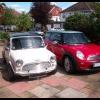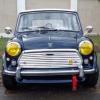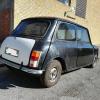The South African Clubman had its own unique history – particularly the 1275GT.
1275GT
As we detailed in Issue 19, the 1275GT was not a replacement for the Cooper S, but for the 998cc Cooper. As such, it had slightly more power – 59bhp as opposed to 55bhp – which was achieved through the cheaper process of using the 1275cc “rationalised” engine from the 1300 (ADO16) range with a single 1½” carburettor.
This was part of Leyland’s plan to rationalise the Mini brand and model range, in an attempt to make the Mini more profitable.
While the Mini Clubman, and the associated Mk3 (ADO20) Mini, was originally conceived under BMC, it was Leyland’s Lord Stokes who insisted on a Cooper replacement with the 1275GT.
When the Mini Clubman and 1275GT were launched in October 1969, the Mini range had been rationalised from sixteen models (Mini 850, Mini Super Deluxe, 998cc Cooper, 1275cc Cooper S, estate models, van and pick-up – all of which were available in Morris or Austin makes. There was also the Riley Elf and the Wolseley Hornet – the Mokes discontinued in 1968) to eight models (Mini 850, Mini 1000, Mini Clubman, Clubman Estate, 1275GT, Cooper S, van and pick-up).
The Clubman and 1275GT were seen as the up-market models from the basic 850 and 1000, and as such commanded a price premium. This made them considerably more profitable for Leyland, given the cost reductions in rationalising the number of models and engines – not just within the Mini range but also in line with the top-selling 1300 range.

Stokes had already decided to eliminate paying royalties to outside “consultants”, and when the contract with Cooper ran out in 1971 the Cooper S was discontinued. The disappointing part for many enthusiasts, was that there was no replacement for the Cooper S, with the 1275GT becoming the top model in the line-up.
This was rectified in part by the availability from Leyland’s Special Tuning concern at Abingdon of a Sports Performance Kit for the 1275GT. This comprised of an additional 1½” SU carb, a new manifold, improved cylinder head and an up-rated distributor.
However, by this time the Mini was no longer competitive in most forms of motorsport (to be proved wrong in 1978 and 1979 when Richard Longman sealed the Touring Car Championship for both years in a somewhat modified 1275GT) and a factory-built sports version of the Mini may not have been as commercially successful as the Cooper S had been during the Mini’s hey-day.
While the 1275GT originally had a 3.65:1 diff ratio, in the interest of giving it a bit more acceleration, it was continually criticized for its noise levels at highway speeds and its reduced top-end. In December 1970 this was replaced with the 3.44:1 diff of the Cooper S, and Hydrolastic suspension was phased out – a significant cost saving.
In 1974 12” wheels and 8.4” disc brakes where introduced, which in turn meant the removal of the brake booster (another cost saving), and the fuel tank was increased from 5½ gal (25lt) to 7½ gal (34lt).
From a sales and profit point of view, the Mini Clubman and 1275GT made a lot of sense. In the eleven years of production 110,673 GTs were sold, which compared favourably with the Cooper models, which in ten years sold 120,000 – but over seven models.
According to Jon Pressnell in his book Mini – The Definitive History, in 1970 Mini registrations in the UK increased by 18.2%, while the overall market increased by 11.5%. In 1971 the figures were even more impressive, with Mini sales up 27.8%, again outperforming the market average.
However, with pressure from improving and cheaper imports, Mini sales slipped in 1972 by 6.7% against the overall market increase of 27.4%. As Pressnell says; “The situation was pretty much stable in 1973, but 1974 demonstrated that the slide had begun.”
This is in line with the often-quoted global production figures for the Mini, which peaked at 318,475 in 1971, remained over 300,000 the following year and then began to decline.
The 1275GT, along with the Mini Clubman, which received the 1098cc engine in October 1975, was replaced by the Mini Metro in 1980.
While the Clubman story was very different in Australia, as detailed in Issues 19 and 25, the South African Clubman had its own unique history – particularly the 1275GT.

The South African Clubman had its own unique history – particularly the 1275GT.
Like Australia, South Africa dictated local content levels to obtain import excise rebates and greater tariff protection. However, where Australia’s local content rules were based on a percentage of production cost, South Africa’s was based on a percentage of vehicle weight.
The South African local content programme was introduced in three phases. According to Ryno Verster in A South African Mini Story; “The first 30% of local content (was) achieved in ‘hang-on’ parts such as bumpers, glass, tyres, seats, electrics, trim, etc. In Phase I of the programme there were no fixed targets – the higher the local content, the bigger the rebates and import permit issues an assembler gained.”
From the start of production in early 1960, South African Minis included locally made brake drums, battery, road wheels, interior trim, boot lid hinges, boot lid lock, bonnet hinges, bumper over-riders and numerous smaller brackets and parts.
Phase II was achieved through functional parts, such as engines, transmissions, etc. and required manufacturers to reach 45% local content (by weight) initially, and 55% by the end of 1969. Interestingly, the engines were considered to be “manufactured” locally if the blocks and other components were imported in rough-cast form and machined in South Africa.
To meet this requirement BMC South Africa began machining and assembling 848cc and 1098cc engines locally in February 1964.
Minis were declared “manufactured” on 1 July 1964 after reaching the required 45% local content. Meanwhile the list of locally made hang-on parts continued to grow, including manifolds, exhausts, generators and other engine components.
“After the required 55% of Phase II was achieved in March 1967, 2½ years ahead of the deadline of the end of 1969, the momentum in local component manufacturing was maintained throughout 1967 and 1968 to be on the front foot for Phase III that kicked in on 1 January 1971”, Ryno reports.
Phase III set a bench mark of 65% local content (by weight) to be achieved by the end of 1976. The Mini reached this target in August 1975, a full seventeen months ahead of schedule.
A major part of this was a new engine block, which was cast in South Africa by Gearings Foundary, at Epping, Cape Town. Based on the UK 1275cc Cooper S engine block, the South African engines featured integral side covers and an internal oil filter gallery, which allowed the filter to be placed high on the block, above the starter motor.
Like the Cooper S engine, the bore was 70.64mm and the stroke was 81.33mm to achieve 1275cc. 1098cc was easily achieved with a shorter-stroke crank and different pistons (and requiring a different camshaft), giving a stroke of 69.85mm – as opposed to the 68.26mm of the 1071cc Cooper S.
This allowed a great deal of interchangeability of parts which, combined with the 1275cc unit being used in the ADO16 models and a local 1300 Marina, provided a significant cost saving over using different engines.
With this background, the South African Mini Clubman was released on 6 August 1971 – ten days before the Clubman was released in Australia. Unlike the Aussie Clubman, though, the Springbok version looked very much like the UK version, with concealed door hinges, full-width winding windows and no door pockets.
Extract taken from 'Mini Experience' magazine, Australia, Issue 26
http://bmcexperience...-26/1275gt.html
Edited by mab01uk, 21 December 2014 - 11:35 PM.


























